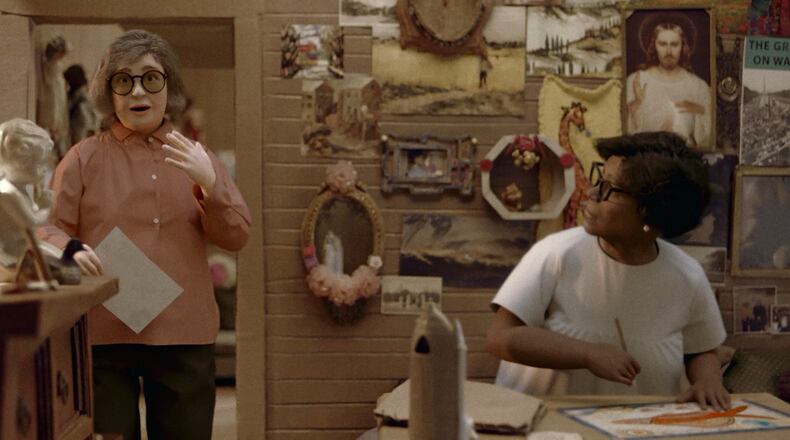Perhaps the most unusual thing about “This World is Not My Own,” the new documentary film about Atlanta folk artist Nellie Mae Rowe, is that the filmmakers have built their own Nellie Mae Rowe from scratch.
With the help of motion-capture technology and the talented actress Uzo Aduba, the movie fashions a three-dimensional digitally animated Rowe and places her in a miniature version of her wildly cluttered house and yard, a house that long ago vanished under the bulldozer’s blade.
In place of that house and yard, the moviemakers fashioned a gingerbread-house-sized stage set, in a tour-de-force of the modeler’s art, with popcorn trees, Lilliputian bottles made from sugar, diminutive cardboard furniture and even tiny recreations of Rowe’s own artwork.
“They did a phenomenal job,” said Rowe’s great-great niece, Cathi Perry. Perry and her sister Cheryl Mashack consulted with the crew, telling them about Aunt Nellie and offering details on her art-saturated world. “They wanted to know what filled the house, what filled the yard,” said Perry, “and we gave them descriptions, photographs, everything we had.”
Said Mashack, the set builders matched those details, “even down to the pictures on the walls.” The film, which premiered at South By Southwest earlier this year, will make its Atlanta premiere Tuesday, April 25, at the High Museum of Art, as part of the Atlanta Film Festival.
Creating a computer-generated doppelganger of the subject of your documentary, and placing it in a miniature stage set is an unorthodox move, but it matches the playful spirit of Rowe, who called her wonderland residence a “playhouse,” and who also liked creating miniature people in the form of dolls.
Credit: High Museum
Credit: High Museum
It is also a creative approach to the limitations the filmmakers faced. There were few interviews with Rowe, very little film or video footage, and a paucity of photographs. “There was no archive of her life,” said Katherine Jentleson, curator of folk art at the High Museum of Art, which mounted an extensive Nellie Mae Rowe exhibit in 2021 called “Really Free: The Radical Art of Nellie Mae Rowe.”
The challenge, said director Petter Ringbom was “to make a film where her presence is alive and her spirit can somehow be reimagined for audiences who have never met her.”
Of Rowe’s animated stand-in, Jentleson said “Nellie Mae Rowe probably would have chuckled at this, and found it fun and true to form.”
Credit: macadmin
Credit: macadmin
Atlanta gallerist Judith Alexander discovered Rowe, and brought her to the attention of museums and collectors in Atlanta and New York. In the film Alexander is also recreated as an animated figure. The connection between the two changed both of their lives. “They were yin and yang,” said Mashack.
Alexander became an advocate for self-taught artists, particularly Rowe, and after Alexander’s death in 2004 the Judith Alexander Foundation continued that work.
In 2016 the foundation sought suggestions from filmmakers about ways to document Rowe’s life. Ringbom and Marquise Stillwell’s New York-based production company, Opendox, was among those pitching ideas.
“Seven years ago I had never heard of Nellie Mae Rowe,” said Ringbom. “I immediately fell in love with her art and her story.”
“We wanted something to help us preserve and expand the legacy of Nellie Mae Rowe,” said Judith Augustine, director of the foundation. “We didn’t realize how creative (Opendox) would get. We were thrilled with it. It went way beyond anything we had envisioned.”
Credit: The High Museum of Art
Credit: The High Museum of Art
The film animates Rowe’s gloriously colorful paintings and drawings, allowing them to spread themselves across the frame after the manner of the living cornfields in an immersive Van Gogh exhibit.
The documentary also uses Rowe’s life as a lens to view the world of post-slavery Jim Crow Atlanta, discovering remarkable connections between her story and some of the most shattering events in the history of the city, including the Atlanta Race Massacre of 1906 and the lynching of Leo Frank.
Rowe lived a life of hard labor. As a girl she worked picking cotton, shelling peas and pulling corn on her parents’ sharecropper farm. Later she worked as a domestic in North Atlanta.
There were perhaps only a few hundred residents of Vinings when Rowe moved there with her first husband Ben Wheat in 1930. “It was a small pocket of Black, and everywhere else was very full of white people,” said Rowe’s great-great nephew Ken Brown, who also lived in the neighborhood. “They weren’t very nice.”
Rowe’s artwork describes and comments on the rapid growth of Vinings, and the conflict that such growth created. Her street became a thoroughfare, and I-285 was carved through nearby neighborhoods. The film opens with a scene of Rowe sweeping her yard as a noisy carload drives past and someone throws a bottle over her fence. She carefully adds it to her bottle tree.
Though her environment was hostile, Rowe never stopped optimistically engaging with those around her. She invited her mostly white neighbors to see her yard and house and collected more than 800 signatures in her guest book just between May 1973 and March 1975.
Her delight in her life, and her pride in her work, are palpable in the movie and in her paintings. Jentleson wrote in the catalog for the 2021 show, “Black joy, rather than suffering, was, by and large, her platform.”
EVENT PREVIEW
“This World is Not My Own”
6:45 p.m. April 25. $20. Hill Auditorium, High Museum of Art, 1280 Peachtree St. NE, Atlanta. 404-733-4400, high.org
About the Author
The Latest
Featured






